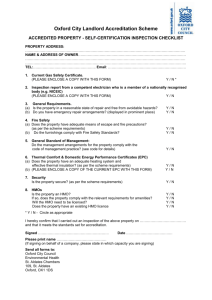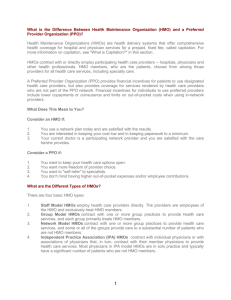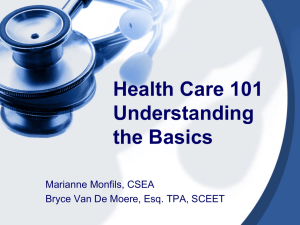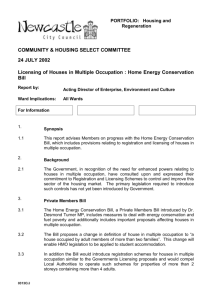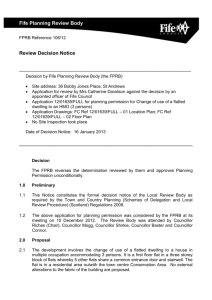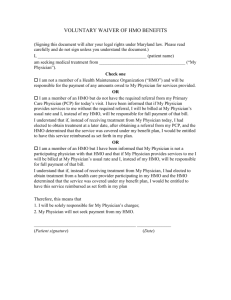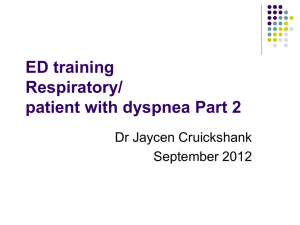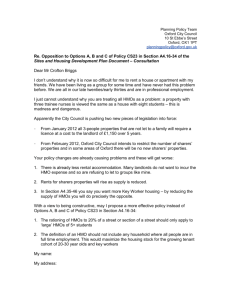(Houses in Multiple Occupation) Guidance and
advertisement
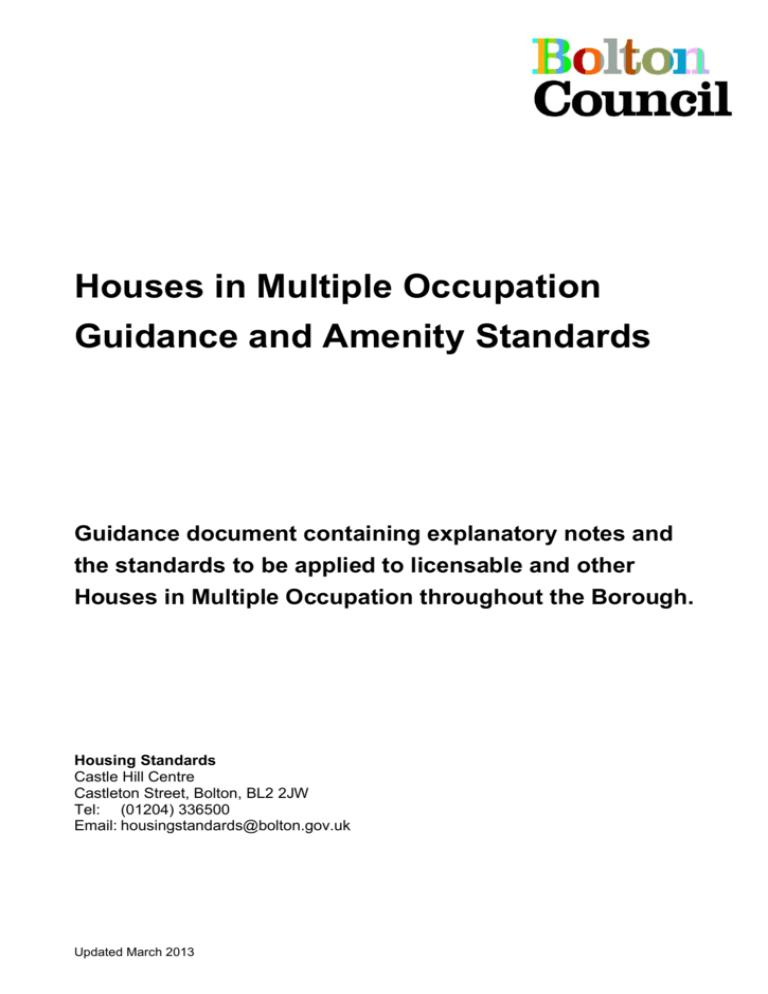
Houses in Multiple Occupation Guidance and Amenity Standards Guidance document containing explanatory notes and the standards to be applied to licensable and other Houses in Multiple Occupation throughout the Borough. Housing Standards Castle Hill Centre Castleton Street, Bolton, BL2 2JW Tel: (01204) 336500 Email: housingstandards@bolton.gov.uk Updated March 2013 Introduction The Council is committed to improving the health, safety and well being of residents within the private rented sector and improving the standards of management by landlords operating in the borough. This document aims to assist those involved in the management of HMO properties in meeting the necessary standards and applicable legislation. Major areas covered by this document include HMO definitions, the mandatory licensing scheme for certain types of HMO accommodation, the Management Regulations and the crowding and amenity standards. Whilst this document should provide readers with a basic knowledge of what is required in this type of accommodation, please feel free to contact the Housing Standards directly on 01204 336500 for any queries you may have. 1 Contents Page Introduction ......................................................................................................................... 1 Contents Page .................................................................................................................... 2 Chapter 1 - Definitions ........................................................................................................ 3 1.1 Definition of an HMO ................................................................................................. 3 1.2 Houses in Multiple Occupation ............................................................................. 3 Chapter 2 – Mandatory HMO Licensing ............................................................................. 4 2.1 Introduction .......................................................................................................... 4 2.2 Mandatory Licensing Fee ..................................................................................... 4 2.3 Mandatory Licensing Application Form ................................................................ 4 2.4 Licensing Procedure and Conditions .................................................................... 5 2.5 Provisions for Appeal ........................................................................................... 5 2.6 Offences and Penalties ........................................................................................ 5 2.7 Planning Permission and Other Statutory Requirements ..................................... 6 2.8 Antisocial Behaviour ............................................................................................. 6 2.9 Advice .................................................................................................................. 7 Chapter 3 – Management of Houses in Multiple Occupation .............................................. 8 Chapter 4 – Crowding and Space Standards ................................................................ .. 12 4.1 Introduction ...................................................................................................... 12 4.2 Crowding and the HHSRS………………………………………………………………… 13 4.3 Table 1 - Crowding and Space Guidance in Cat A HMO property…………………… 14 4.4 Table 2 - Crowding and space standards in Cat B HMO property…………………….. 15 Chapter 5 – Amenity Standards........................................................................................ 15 5.1 Facilities for Storage & Cooking of Food & Disposal of Waste Water…………... 16 5.2 Personal Washing Facilities ............................................................................... 16 Chapter 6 – Certification ................................................................................................... 17 6.1 Gas Safety (Installation and Use) Regulations 1998 .......................................... 17 6.2 Electrical Safety ................................................................................................. 17 6.3 Furniture Safety .................................................................................................. 17 6.4 Fire Safety .......................................................................................................... 18 Appendix A – Fit and Proper Person ................................................................................ 19 Appendix B – Examples of HMOs and licensable HMOs ................................................. 20 2 Chapter 1: Definitions Chapter 1 - Definitions 1.1 Definition of a House in Multiple Occupation (HMO) The Housing Act 2004 contained a complex and comprehensive definition of what constitutes an HMO. For the purposes of this guidance a simplified definition is more useful which aims to give landlords an understanding of what constitutes an HMO. In most general terms, an HMO is a dwelling (a building or part of a building) that is occupied by three or more people who do not form a single household AND who share one or more basic amenties. A household for the purposes of the Housing Act 2004 can be defined as a group of persons who are all members of the same family (this includes spouses, blood relatives, cohabitees and same sex couples), whilst amenities can be taken to mean toilets, personal washing facilities and cooking facilities. The exception to this definition is self contained flats that do not comply with the Building Regulations of 1991 (i.e. they were converted before these regulations were in force). Despite the fact that there is likely to be no sharing of basic amenities in this type of property, they are classed as HMOs for the purposes of the Housing Act 2004. This definition should not be confused with the definition of a licensable HMO – more information with regard to mandatory HMO licensing can be found in chapter 2 of this guide. 1.2 Houses in Multiple Occupation There are a number of different types of HMO: Bedsits / Shared houses Individual rooms sharing bathrooms, toilets and in some cases kitchens Hostels and Bed and Breakfast Establishments Accommodation is for persons with no other place of residence. The provision of some meals is characteristic. Self contained flats (That do not comply with the Building Regulations 1991) Houses converted into self-contained flats with no shared amenities. All amenities are behind a flat entrance door 3 Chapter 2: Mandatory HMO Licensing Chapter 2 – Mandatory HMO Licensing 2.1 Introduction HMOs which comprise of three or more storeys and are occupied by five or more persons, who comprise two or more households will be subject to this licensing regime (Other than those that are exempt from licensing). In calculating three storeys, regard should be had to attic or basement accommodation used, or capable of being used, for residential purposes. It is also intended that any part of a building not used for residential purposes, such as commercial premises on the ground or upper floor of a building, will form part of the HMO for determining the number of storeys. Basements in purely commercial use will not be included. A Council can introduce additional licensing schemes that may apply to HMOs (other than those that are exempt from licensing or already subject to mandatory licensing) in its area, or any part of it. Please see appendix B for examples of which types of properties are licensable. 2.2 Mandatory Licensing Fee Under the new licensing arrangements the Council will make a charge for administering and issuing a licence. Fees must however, reflect the actual costs of licensing a property and have a structure which is fair and transparent. A licence will last for a maximum of five years, although it may be issued for a shorter period in certain circumstances. 2.3 Mandatory Licensing Application Form The information provided within the application form contains information, which will be used to process and determine the application. Such information, as required, will be declared within a public register of licensable HMOs. It is a legal requirement for Local Authorities to provide a register of all specific details relating to licensable HMOs. Anyone can request to view a public register by visiting the relevant council offices (see front cover for details). The public register will contain information as required by Section 11 of the Licensing and Management of Houses in Multiple Occupation and Other Houses (Miscellaneous Provisions) (England) Regulations 2006 (these regulations can be accessed through www.legislation.gov.uk). In summary the following information will be held: Name and address of licence holder Address of the property to be licensed Basic information on the property to be licensed (i.e. number of storeys, number and type of rooms etc). The maximum number of households permitted to occupy the HMO 4 Chapter 2: Mandatory HMO Licensing 2.4 Licensing Procedure and Conditions Anyone who owns or manages a HMO that must be licensed has to apply to the council for a licence. For the Council to issue a licence it must be satisfied that the: HMO is reasonably suitable for occupation by the number of people allowed under the licence; Proposed licence holder is a fit and proper person (for further information on fit and proper person see Appendix A); Proposed licence holder is the most appropriate person to hold the licence; Proposed manager, if there is one, is fit and proper; Proposed management arrangements are satisfactory, the person involved in the management of the HMO is competent and the financial structures for the management are suitable. Standard mandatory licensing conditions: Licence holders to provide the Council with a gas certificate every year; Duty to keep electrical appliances and furniture provided by the licence holder in a safe condition and supply on demand to the Council a declaration to that affect; Duty to ensure that fire alarms/smoke detectors are installed and maintained in proper working order and supply on demand to the Council a declaration as to their condition and location; Provide occupiers with a written statement of the terms on which they occupy the property; The licensed premises will comply with all statutory requirements this includes current and future Management Regulations. 2.5 Provisions for Appeal You may appeal if the council decides to: refuse a licence grant a licence with conditions revoke a licence vary a licence refuse to vary a licence. Appeals should be made to the Residential Property Tribunal, normally within 28 days. The Tribunal will also hear appeals regarding any enforcement notices that the Council may serve. 2.6 Offences and Penalties Failure to licence a licensable HMO is a criminal offence with a maximum fine of £20,000. Where a property is licensable but the landlord, does not apply for one and therefore operates without a licence then no rent or other charge may be taken for the property and Section 21 of the 5 Chapter 2: Mandatory HMO Licensing Housing Act 1988 (Notice Requiring Possession of an Assured Shorthold Tenancy) is unavailable as grounds for eviction. Breaching any licensing condition is a criminal offence with a maximum fine of £5,000 per offence. Where licensing arrangements have been breached, the Council or an occupier of the HMO can apply to the Residential Property Tribunal for a rent repayment order for the return of Housing Benefit or the rent paid within the previous 12 months. 2.7 Planning Permission and Other Statutory Requirements Compliance with the provisions of this scheme does not confer exemption from the need to obtain any planning permission necessary for operation of a house in multiple occupation or from action by the Council under other legislation. The Council may serve a range of notices in respect of houses in multiple occupation. These include notice requiring the execution of works to reduce health and safety hazards identified; notice requiring steps to be taken to reduce the level of occupancy; notice to remedy neglect of management and powers to take over poorly managed properties. These powers operate independently of any licensing scheme. You are advised to establish lawful use of your premises under planning legislation. It is also advisable to contact Building Control for Building Regulation advice. 2.8 Antisocial Behaviour Antisocial behaviour covers a wide range of problems and includes any behaviour that is capable of causing nuisance or annoyance to an individual(s) or the wider community. This type of behaviour can include: Harassment and intimidating behaviour Hate crime, for example racist or homophobic abuse Behaviour that creates alarm and fear Noisy neighbours and loud parties Problems associated with people supplying, dealing or using drugs People acting in a manner which is likely to caues distress or nuisance to others, due to the consumtion of alcohol Vandalism, graffiti and other deliberate damage to property Rubbish or litter lying around, abandoned cars etc Anti-social behaviour may or may not constitute criminal activity. The key determinant in deciding whether particular behaviour is anti-social or not should be the impact of the behaviour on others. As a licensed landlord it will be your duty to take reasonable steps to ensure that tenants and their visitors are not causing problems within the boundaries of the property through anti-social behaviour. For example, if the landlord has a complaint from a neighbour about loud music late at night or rubbish left lying around the property, it would be the responsibility of the landlord to talk to the tenants and work with other agencies such as the local housing authority to try to resolve any problems. If the local housing authority sets a condition on the licence about anti-social behaviour it will be expected to work closely with landlords to combat the problem. 6 Chapter 2: Mandatory HMO Licensing 2.9 Advice For further information and the contact details of other useful organisations, including Housing Advice, Antisocial Behaviour Officers and Bolton Accredited Residential Landlords Organisation please contact the Housing Standards at the address below: Housing Standards, Castle Hill Centre, Castleton Street, Bolton, BL2 2JW Tel: 01204 336500 Email: housingstandards@bolton.gov.uk 7 Chapter 3:Management of Houses in Multiple Occupation Chapter 3 – Management of Houses in Multiple Occupation The Management of Houses in Multiple Occupation (England) Regulations 2006 prescribe the duties of the manager of a HMO. Compliance with these regulations is also a condition of Mandatory Licensing. Duty of manager to provide information to occupier The manager must ensure that— (a) (b) his name, address and any telephone contact number are made available to each household in the HMO; and such details are clearly displayed in a prominent position in the HMO. Duty of manager to take safety measures The manager must ensure that all means of escape from fire in the HMO are— (a) (b) kept free from obstruction; and maintained in good order and repair. The manager must ensure that any fire fighting equipment and fire alarms are maintained in good working order. The manager must ensure that all notices indicating the location of means of escape from fire are displayed in positions within the HMO that enable them to be clearly visible to the occupiers. This does not apply where the HMO has four or fewer occupiers. The manager must take all such measures as are reasonably required to protect the occupiers of the HMO from injury, having regard to— (a) the design of the HMO; (b) the structural conditions in the HMO; and (c) the number of occupiers in the HMO. In performing the duty imposed by the above, the manager must in particular— a. b. in relation to any roof or balcony that is unsafe, either ensure that it is made safe or take all reasonable measures to prevent access to it for so long as it remains unsafe; and in relation to any window the sill of which is at or near floor level, ensure that bars or other such safeguards as may be necessary are provided to protect the occupiers against the danger of accidents which may be caused in connection with such windows. 8 Chapter 3:Management of Houses in Multiple Occupation Duty of manager to maintain water supply and drainage The manager must ensure that the water supply and drainage system serving the HMO is maintained in good, clean and working condition and in particular he must ensure that— (a) (b) any tank, cistern or similar receptacle used for the storage of water for drinking or other domestic purposes is kept in a good, clean and working condition, with a cover kept over it to keep the water in a clean and proper condition; and any water fitting which is liable to damage by frost is protected from frost damage. The manager must not unreasonably cause or permit the water or drainage supply that is used by any occupier at the HMO to be interrupted. In this regulation "water fitting" means a pipe, tap, cock, valve, ferrule, meter, cistern, bath, water closet or soil pan used in connection with the supply or use of water, but the reference in this definition to a pipe does not include an overflow pipe or the mains supply pipe. Duty of manager to supply and maintain gas and electricity The manager must supply to the local housing authority within 7 days of receiving a request in writing from that authority the latest gas appliance test certificate it has received in relation to the testing of any gas appliance at the HMO by a recognised engineer (i.e. an engineer who is recognised by the Council of Registered Gas Installers). The manager must— (a) (b) (c) ensure that every fixed electrical installation is inspected and tested at intervals not exceeding five years by a person qualified to undertake such inspection and testing; obtain a certificate from the person conducting that test, specifying the results of the test; and supply that certificate to the local housing authority within 7 days of receiving a request in writing for it from that authority. The manager must not unreasonably cause the gas or electricity supply that is used by any occupier within the HMO to be interrupted. Duty of manager to maintain common parts, fixtures, fittings and appliances The manager must ensure that all common parts of the HMO are— (a) (b) (c) maintained in good and clean decorative repair; maintained in a safe and working condition; and kept reasonably clear from obstruction. In performing the above duty, the manager must in particular ensure that— (d) (e) all handrails and banisters are at all times kept in good repair; such additional handrails or banisters as are necessary for the safety of the occupiers of the HMO are provided; 9 Chapter 3:Management of Houses in Multiple Occupation (f) (g) (h) (i) any stair coverings are safely fixed and kept in good repair; all windows and other means of ventilation within the common parts are kept in good repair; the common parts are fitted with adequate light fittings that are available for use at all times by every occupier of the HMO; and fixtures, fittings or appliances used in common by two or more households within the HMO are maintained in good and safe repair and in clean working order. These duties do not apply in relation to fixtures, fittings or appliances that the occupier is entitled to remove from the HMO or which are otherwise outside the control of the manager. The manager must ensure that— (j) (k) (l) outbuildings, yards and forecourts which are used in common by two or more households living within the HMO are maintained in repair, clean condition and good order; any garden belonging to the HMO is kept in a safe and tidy condition; and boundary walls, fences and railings (including any basement area railings), in so far as they belong to the HMO, are kept and maintained in good and safe repair so as not to constitute a danger to occupiers. If any part of the HMO is not in use the manager shall ensure that such part, including any passage and staircase directly giving access to it, is kept reasonably clean and free from refuse and litter. "common parts" means— (i) (ii) (iii) the entrance door to the HMO and the entrance doors leading to each unit of living accommodation within the HMO; all such parts of the HMO as comprise staircases, passageways, corridors, halls, lobbies, entrances, balconies, porches and steps that are used by the occupiers of the units of living accommodation within the HMO to gain access to the entrance doors of their respective unit of living accommodation; and any other part of an HMO the use of which is shared by two or more households living in the HMO, with the knowledge of the landlord. Duty of manager to maintain living accommodation The manager must ensure that each unit of living accommodation within the HMO and any furniture supplied with it are in clean condition at the beginning of a person's occupation of it. The manager must ensure, in relation to each part of the HMO that is used as living accommodation, that— (a) the internal structure is maintained in good repair; (b) any fixtures, fittings or appliances within the part are maintained in good repair and in clean working order; and (c) every window and other means of ventilation are kept in good repair. These regulations do not require the manager to carry out any repair the need for which arises in consequence of use by the occupier of his living accommodation otherwise than in a tenant-like manner. 10 Chapter 3:Management of Houses in Multiple Occupation The duties outlined above do not apply in relation to furniture, fixtures, fittings or appliances that the occupier is entitled to remove from the HMO or which are otherwise outside the control of the manager. For the purpose of this regulation a person shall be regarded as using his living accommodation otherwise than in a tenant-like manner where he fails to treat the property in accordance with the covenants or conditions contained in his lease or licence or otherwise fails to conduct himself as a reasonable tenant or licensee would do. Duty to provide waste disposal facilities The manager must— (a) ensure that sufficient bins or other suitable receptacles are provided that are adequate for the requirements of each household occupying the HMO for the storage of refuse and litter pending their disposal; and (b) make such further arrangements for the disposal of refuse and litter from the HMO as may be necessary, having regard to any service for such disposal provided by the local authority. Duties of occupiers of HMOs Every occupier of the HMO must— (a) conduct himself in a way that will not hinder or frustrate the manager in the performance of his duties; (b) allow the manager, for any purpose connected with the carrying out of any duty imposed on him by these Regulations, at all reasonable times to enter any living accommodation or other place occupied by that person; (c) provide the manager, at his request, with any such information as he may reasonably require for the purpose of carrying out any such duty; (d) take reasonable care to avoid causing damage to anything which the manager is under a duty to supply, maintain or repair under these Regulations; (e) store and dispose of litter in accordance with the arrangements made by the manager under regulation 9; and (f) comply with the reasonable instructions of the manager in respect of any means of escape from fire, the prevention of fire and the use of fire equipment. General Nothing in these Regulations shall— (a) require or authorise anything to be done in connection with the water supply or drainage or the supply of gas or electricity otherwise than in accordance with any enactment; or (b) oblige the manager to take, in connection with those matters, any action which is the responsibility of a local authority or any other person, other than such action as may be necessary to bring the matter promptly to the attention of the authority or person concerned. Any duty imposed by these Regulations to maintain or keep in repair are to be construed as requiring a standard of maintenance or repair that is reasonable in all the circumstances, taking account of the age, character and prospective life of the house and the locality in which it is situated. 11 Chapter 4:Crowding and Space Standards Chapter 4 – Crowding and Space Standards 4.1 Introduction Lack of space and overcrowded conditions have been linked to a number of health outcomes, including psychological distress and mental disorders, especially those associated with a lack of privacy and childhood development. Crowding can result in an increased in heart rate, increased perspiration, reduction of tolerance, and a reduction of the ability to concentrate. Crowded conditions are also linked with increased hygiene risks, an increased risk of accidents, and spread of contagious disease. Within a dwelling there should be sufficient space for the separation of different household activities, either by physical separation or by a clearly defined space within a larger space. The degree of separation is partly dependent on the number of people who can be expected to share the space, and whether or not they are expected to be part of the same household. 4.2 Crowding and the HHSRS Guidance has been provided by the Government to assist officers in assessing the hazard posed by overcrowding in HMO properties. Where an officer believes that conditions are overcrowded, a risk assessment will be undertaken using the HHSRS and the score generated will guide any action taken. Sufficient space must be provided for the separation of household activities and adequate space provided to allow households tasks to be undertaken in a safe manner without the risk of collision (e.g. cooking). Within each unit there must be sufficient space for the separation of domestic activities e.g. cooking and sleeping in bedsit type accommodation. Privacy must also be considered to allow occupants to spend time alone, for example bathrooms and toilets must have locks to allow occupants to feel they have the right to privacy. The tables provided on the next three pages are to provide landlords with guidance as to what room sizes are acceptable for a variety of HMO type accommodation. Room sizes for private halls of residence and B&B type accommodation have been omitted but guidance will be provided from officers upon request. 12 Chapter 4:Crowding and Space Standards 4.3 Table 1 Crowding and space guidance in Category A type HMO property Category A type accommodation covers HMOs where there is some exclusive occupation (usually bedroom/living room) and some sharing of amenities. It also covers self contained flats that do not comply with the 1991 Building Regulations where there will be no sharing of amenities. Property Type Kitchen Bedsit / self contained flat – One person Bedsit / self contained flat – Two persons, two or more rooms‡ Bedroom 4.65 6.5 4.65 10.22 Living room 9.0 12 Room(m2) Living / Living / Bedroom kitchen 10.22 (shared 11.0 kitchen) 14.0 15.0 † Single room untis are only suitable for individuals, unless they are married or co-habiting couples. In the case of a 2 couple living in one room accommodation, it must not be less than 15m . Sharing of bedrooms between two people of the opposite sex and over 12 years of age is not permitted ‡ In unusual circumstances where there are more than two persons sharing a two or more room bedsit or self contained 2 flat, each room must be of a suitable size to accommodate the number of tenants (as a guide use 2m for each room per additional occupant) 13 Living /kitchen/ bedroom 13 - Chapter 4:Crowding and Space Standards 4.4 Table 2 Crowding and space standards in Category B type HMO accommodation Category B type accommodation covers houses occupied on a shared basis. They would normally be members of a defined social group e.g. students or young single adults. This kind of HMO has many of the characteristics of a single occupancy dwelling. Bedrooms – 1 person without separate living room = 10.22m2 1 person with separate living room = 6.5 m2 2 persons without separate living room = 15m2 2 persons with separate living room = 11 m2 Room 2 2 Kitchen (m ) Kitchen/ 2 Dining (m ) Dining/Living (m ) 1-3 5 10 8.5 4-6 8 11.5 11 7-9 9 15 16.5 10-12 13.5 19.5 21.5 No. of occupants 14 Chapter 5: Amenity Standards Chapter 5 – Amenity Standards 5.1 Facilities for Storage, Preparation & Cooking of Food & Disposal of Waste Water There must be adequate and sufficient facilities for the storage, preparation and cooking of food and the disposal of waste water for the number of persons in occupation. The standards given below are legislative requirements in licensable properties and provide useful guidance for non-licensable HMOs General Requirements Adequate means of ventilation and artificial lighting must be provided. Not more than one floor distant from any user. Adequate work surfaces to allow the safe preparation of food Adequate refrigerated, frozen and dry storage to allow food to be stored safely Adequate appliances and equipment for the cooking of food. For example cooker, grill and four rings for 1-4 people. Other solutions for example involving combined microwaves will be considered on a case by case basis. Sink with draining board, with adequate supply of cold water and constant hot water 1 per 4 persons Kitchen to have at least 6 electrical sockets plus 2 more for each additional tenant when the occupancy level exceeds 6. Appropriate refuse disposal facilities for the number of tenants. Where kitchen facilities are provided in individual rooms, with no shared kitchen Two rings, oven and grill. Requirement for oven can be substituted by a combined microwave / oven (will need to be PAT tested). Portable electric cookers would be acceptable if installed at a safe working height and properly serviced. Sink with adequate supply of cold water and constant hot water Adequate work surface to allow an individual tenant to prepare food safely Six electrical sockets in kitchen area Adequate dry and refrigerated storage space 15 Chapter 5: Amenity Standards 5.2 Personal Washing Facilities The standards given below are legislative requirements in licensable properties but do provide useful guidance for non-licensable HMOs General requirements All toilets and bathrooms must be suitably located in relation to the living accommodation in the HMO i.e. amenities shared by two or more households must be accessible from a common area, toilets must not open into kitchens and must not be more than one floor distance away from any user. Natural or mechanical extract ventilation; the latter is desirable even if natural ventilation is present and is essential for shared facilities. Adequate heating in the bathroom Every WC must be provided with a wash-hand basin with constant supplies of hot and cold water and trapped waste outlet. The WHB should be sited within the WC compartment. Self contained Flats 1 water closet, wash hand basin and bath or shower per flat Bedsits, Shared Houses, Hostels and Halls of Residence 1 – 4 persons At least 1 bathroom and WC (the bathroom and WC may be combined) 5 Persons 1 bathroom AND 1 separate WC with WHB (but the WC can be contained within a second bathroom). 6 – 10 persons 2 bathrooms AND 2 separate WCs with WHBs (but one of the WCs can be contained within one of the bathrooms.) 11 – 15 persons 3 bathrooms AND 3 separate WCs with WHBs (but two of the WCs can be contained within two of the bathrooms). 16 Chapter 6 Certification Chapter 6 – Certification 6.1 Gas Safety (Installation and Use) Regulations 1998 As a landlord, you are responsible for the safety of your tenants. The Gas Safety (Installation and Use) Regulations 1998 specifically deal with the duties of landlords to ensure that gas appliances, fittings and flues provided for tenants' use are safe. As a landlord, you have a duty to ensure: Gas fittings (appliances, pipework) and flues are maintained in a safe condition; All installation, maintenance and safety checks are carried out by a Gas Safe registered Installer; An annual safety check is carried out on each gas appliance/flue by a Gas Safe registered Installer. Checks need to have taken place within one year of the start of the tenancy/lease date, unless the appliances have been installed for less than 12 months, in which case they should be checked within 12 months of their installation date; A record of each safety check is kept for two years; A copy of the current safety check record is issued to each existing tenant within 28 days of the check being completed, or to any new tenant before they move in (in certain cases the record can be displayed). 6.2 Electrical Safety The electrical installation to the property should be installed and maintained in accordance with a recognised standard, such as the current edition of the IEE (Institute of Electrical Engineers) Wiring Regulations and a satisfactory periodic inspection report must be obtained. The installation should be retested and certified, as described every five years, or following any alterations or extensions to the system. All work to the electrical installation should be carried out and certified by a NICEIC (National Inspection Council for Electrical Installation Contracting) member or approved body or competent person. All electrical work must be carried out in accordance with Part P of the Building Regulations. 6.3 Furniture Safety All furniture provided with the accommodation must comply with the Furniture and Furnishings (Fire) (Safety) Regulations 1988 (as amended). You are required to sign a declaration on the application form to the effect that the above condition is met. 17 Chapter 6 Certification 6.4 Fire Safety A certificate confirming the correct installation and operation of the fire alarm system must be submitted with the application. Certificates should conform to the relevant British Standard (either BS5839 Part 1:2002 or BS 5839 Part 6:2004) and state the sound levels achieved within each room and circulation areas. Thereafter all such certificates must be made available at the request of the Council and on relicensing. Once copied, any original certificates that have been provided will be returned to the applicant 6.5 Fire Safety Guidance For detailed guidance about the required safety measures in HMOs please refer to the LACORS national fire safety guidance “Housing - Fire Safety Guidance on Fire Safety Provisions for Certain Types of existing housing”. This can be downloaded free of charge from www.lacors.gov.uk 18 Appendix A: Fit & Proper Person Appendix A – Fit and Proper Person The council will carry out checks to make sure that the person(s) applying for the licence is a fit and proper person. This may, if required, involve the applicant completing a Disclosure Application with Disclosure Scotland. This check will show all unspent convictions under the Rehabilitation of Offenders Act 1974. Under Section 64(3)(b) & (d), in granting a licence, the Council must be satisfied that the proposed licence holder, proposed manager and agent or employee are fit and proper persons, in doing so the Council must have regard to any evidence within the list below. a) Committed an offence involving Fraud Dishonesty Violence Drugs Sexual Offences Act 2003 Schedule 3 b) Practised unlawful discrimination on grounds of sex, colour, race, ethnic or national origins or disability in connection with a business. c) Contravened any provision of Housing, Public Health, Environmental Protection or Building Act Legislation or been served with a notice and in particular been in control of any property within the last five years that has been: Subject to a control Order under s379 of the Housing Act 1985 Subject to civil or criminal proceedings in respect of the above legislation resulting in a judgement being made. Where the Local Authority has had to carry out works in default Subject to a management Order under the Housing Act 2004 d) Or been refused a licence or breached conditions of a licence. We may approach other Authorities such as the Police Authority, Fire and Rescue Service, Office of Fair Trading, County Court and other Local Authorities etc, for information and confirmation. Signing of the application will be taken as your agreement to any such action. 19 Appendix B :HMO example diagrams Appendix B – Examples of HMOs and licensable HMOs Diagram 1 – Examples of non-licensable HMOs 20 Appendix B :HMO example diagrams Diagram 2 - Examples of Licensable HMOs 21

